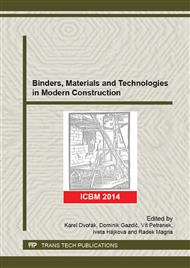p.87
p.91
p.97
p.101
p.106
p.112
p.116
p.120
p.124
The Assessment of Durability of Fibre Concretes with Dense Aggregate and Concrete Recyclate from the Results of Permeability and Diffusion Tests
Abstract:
The mechanical and deformation characteristics of mass concrete are considerably improved by adding long structural fibres. This addition, however, does not always extend the durability of concrete. One of the key factors in the evaluation of durability of fibre concretes is the assessment of permeability of their surface layer using one of the non-destructive methods. In this research, three of these methods were used: two permeation methods with a gaseous medium, TORRENT and CO2 permeability method, and the British ISAT with a liquid medium, on the grounds of their simplicity of application and their possible combinability. The test results show that both TORRENT and ISAT methods can be used to assess the durability of both concrete and fibre concrete with dense aggregate. In the case of concrete containing concrete recyclate, however, the TORRENT method was not effective. Also the method of determining the permeability for CO2 was not suitable for the concrete with concrete recyclate. Even for other concretes this method was too complicated and too dependent on the marginal conditions of the measurement.
Info:
Periodical:
Pages:
106-111
Citation:
Online since:
April 2015
Authors:
Price:
Сopyright:
© 2015 Trans Tech Publications Ltd. All Rights Reserved
Share:
Citation:


